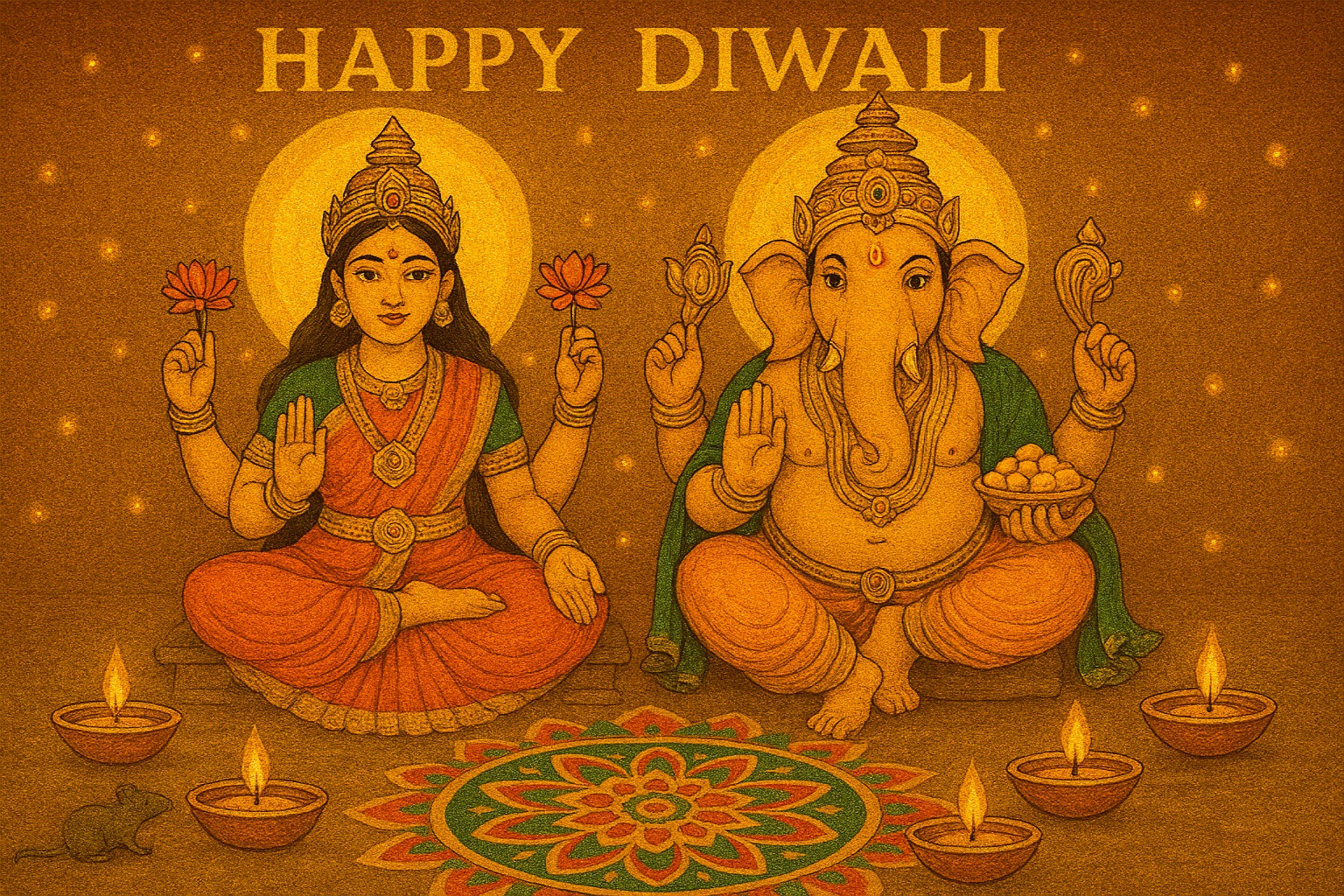Diwali, or Deepavali, is one of the most celebrated festivals in India — a time when millions of homes sparkle with lights, joy, and devotion. But beyond the fireworks and sweets lies a festival rich in both spiritual depth and scientific wisdom.
Let’s explore why Diwali is celebrated, and how each ritual, from lighting diyas to cleaning homes, carries both spiritual significance and scientific purpose.
Table of Contents
1. When & Why – The Timing and the True Meaning
Spiritual Perspective
Diwali falls on the Amavasya (new moon night) of the Hindu month Kartik — usually between October and November. According to the Ramayana, this day marks the return of Lord Rama, Mata Sita, and Lakshman to Ayodhya after 14 years of exile and victory over the demon king Ravana. The people of Ayodhya celebrated by lighting countless lamps, symbolizing the victory of dharma (righteousness) over adharma (evil).
It’s also believed that Lord Krishna destroyed the demon Narakasura a day before Diwali, freeing the world from his tyranny. Thus, Diwali is also known as Naraka Chaturdashi in some regions, celebrating the defeat of darkness and ignorance.
Scientific Perspective
Diwali coincides with the transition from monsoon to winter — a time when humidity reduces and insects, bacteria, and molds multiply. The lighting of lamps and burning of camphor and incense help purify the air and reduce humidity indoors.
The festival also marks harvest completion, symbolizing a new beginning — emotionally, financially, and environmentally — aligning perfectly with the human need for renewal and balance before winter.
2. The Light of Diyas – Symbol of Inner Illumination 🪔
Spiritual Perspective
Lighting diyas (clay lamps) represents dispelling darkness from the mind and soul. The flame symbolizes knowledge, wisdom, and the presence of the Divine. In the Upanishads, “Tamaso mā jyotir gamaya” — “Lead me from darkness to light” — captures this essence beautifully.
Each diya is also an offering to Agni Deva (the Fire God), believed to carry prayers to the heavens. Rows of diyas during Diwali symbolize the collective effort of humanity to drive away ignorance and embrace divine light.
Scientific Perspective
The oil lamps and camphor used in diyas release small amounts of natural antimicrobial substances, helping cleanse the air during seasonal changes.
The warm glow of multiple diyas creates a calming visual effect, triggering the release of serotonin and endorphins, promoting mental peace and happiness.
The act of lighting lamps together also strengthens social bonding — a key factor in mental well-being.
3. Home Decoration – Cleaning and Beautifying the Sacred Space 🌺
Spiritual Perspective
In Sanatan Dharma, cleanliness is equated with divinity — “Cleanliness is next to Godliness.” Before Diwali, homes are thoroughly cleaned and decorated with flowers, torans (leaf garlands), and rangolis (colored floor art) to welcome positive energy and the Goddess of wealth, Lakshmi.
A clean home is seen as a reflection of a pure mind, creating a sacred space where divine energies can dwell.
Scientific Perspective
After the monsoon, dampness leads to the growth of mold, pests, and bacteria. Cleaning the house removes these harmful elements, ensuring a healthier environment.
Decorating with flowers and rangoli introduces natural fragrances and colors, which are known to lift mood and reduce stress.
Moreover, the act of organizing and decorating one’s space has a positive psychological impact, offering a sense of renewal and satisfaction.
4. Mata Lakshmi – The Goddess of Prosperity and Inner Abundance 💰
Spiritual Perspective
Mata Lakshmi, the Goddess of wealth, prosperity, and purity, is believed to visit every household during Diwali night. She blesses those who are clean, humble, and devoted.
Her presence reminds devotees that true wealth is not only material but also spiritual — kindness, gratitude, and harmony.
In the Samudra Manthan (churning of the cosmic ocean), Mata Lakshmi emerged as divine energy, bringing abundance to the world. Thus, Diwali marks her arrival — the light of prosperity illuminating human life.
Scientific Perspective
Financial planning and renewal are central to Diwali. In many Indian traditions, new financial books and accounts are started on this day — a symbolic reset for prosperity.
Psychologically, rituals that mark fresh beginnings help reduce anxiety, improve motivation, and foster a sense of hope and purpose, key components of mental well-being.
5. The Holy Trinity – Mata Lakshmi, Lord Ganesha & Lord Kuber 🙏
Spiritual Perspective
On Diwali night, three divine forms are especially worshipped:
- Mata Lakshmi — for wealth and purity
- Lord Ganesha — for wisdom and the removal of obstacles
- Lord Kuber — the celestial treasurer of the gods
Together, they symbolize spiritual and material balance — wisdom (Ganesha) to earn wealth (Kuber) with humility and devotion (Lakshmi).
Scientific Perspective
The triad represents a perfect psychological framework for success:
- Ganesha symbolizes clear thinking and mindful decision-making.
- Lakshmi represents productivity and prosperity.
- Kuber signifies organization and financial responsibility.
Honoring these principles creates mental focus and financial discipline, improving quality of life — both materially and emotionally.
6. The Spirit of Celebration – Joy, Unity, and Renewal
Spiritual Perspective
Diwali is a time when families unite, friends exchange gifts, and communities celebrate with love. It represents the triumph of joy, unity, and hope over despair. The festival encourages forgiveness, gratitude, and generosity — the true light of the soul.
Scientific Perspective
Group celebrations stimulate oxytocin release, the “bonding hormone,” reducing loneliness and depression.
The sound of fireworks, though controversial, was originally symbolic of warding off negative energies and insects during seasonal transitions.
The overall festivity brings emotional rejuvenation, preparing people to face the winter months with renewed enthusiasm and optimism.
In Essence ✨
Diwali is not just about lamps and sweets — it’s a festival of illumination in every sense.
Spiritually, it reminds us that light always conquers darkness.
Scientifically, it teaches us the wisdom of clean living, renewal, and positive energy.
As diyas flicker in every home, they echo a timeless truth —
“When there is light within, no darkness can exist outside.” 🌼🕯️

